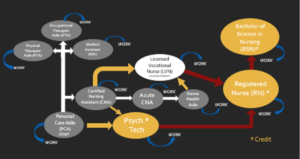Continued collaboration between credit and noncredit faculty has driven the success of Noncredit Career Pathways. These collaborations have led to the creation of noncredit short-term vocational pathways, as well as pathways from noncredit career technical education (CTE) to credit career technical education. An example of this would be the Health Careers Pathways, the pathways for which are illustrated in the graphic below. The gray circles represent noncredit short-term vocational pathways. Students can start one noncredit program, such as Personal Care Aide, to gain foundational skills and training. Upon completion, most go on to enroll in another noncredit health program, such as Certified Nursing Assistant, Medical Assistant, or Physical Therapist Aide. At any time along the pathway, a student may enter the workforce, allowing them to gain more hands-on experience and work experience. Alternately, students may complete a noncredit program and then transition into a credit program. For example, students often begin in the noncredit Personal Care Aide program, then advance to the Certified Nursing Assistant program and then move on to the Registered Nurse program, leading to a Bachelor of Science in Nursing (BSN).

The courses developed as part of Noncredit Career Pathways have supported student completion, which has increased student retention and persistence. One such example is the use of the Reading and Writing for College Career Readiness course in the EMT program. The Mt. SAC faculty lead, in 2017, created a contextualized workforce preparation reading and writing course (VOC-RWCCR) for the region so it could be contextualized for several different career technical education disciplines. VOC-RWCCR is now being used as an Emergency Medical Technician support course at one college to help students improve their research-paper writing skills, in addition to other reading and writing skills, such as annotating a text, note-taking, test-taking strategies, and vocabulary strategies. The faculty lead also worked with a librarian to develop a research workshop designed to show students tools and databases they could use in their research. As a result of this collaboration, student pass rates improved by 11% and overall certificate completion rates improved by 24% from 2017-18 to 2018-19, which was when the EMT support course was first offered. In the following pathway, you can see how successful completion of noncredit EMT 90A and EMT 90 enable a student to continue into a credit program pathway or enter the workforce.

Due to the success of this EMT support course, other career technical education departments in areas such as Fire Technology and Aircraft Maintenance have sought to collaborate on a similar course to support student success and pathway persistence.
Often, the faculty lead is contacted by credit faculty to collaborate on the creation of noncredit career technical education courses that often lead to pathway development. One such example was a collaboration with Graphic Design faculty at Rio Hondo College. During the initial conversation, the faculty lead asked the Graphic Design faculty member, “What would you like your students to know before they enter your program?” From there, a lightbulb emerged and the two developed Career Exploration: Graphic Design, a four-course noncredit certificate that serves as a bridge between noncredit graphic design and credit graphic design. The faculty lead served as the noncredit curriculum expert, and the graphic design faculty member served as the content expert. Upon completion of this certificate, students are well-prepared to transition into the credit Graphic Design program.
